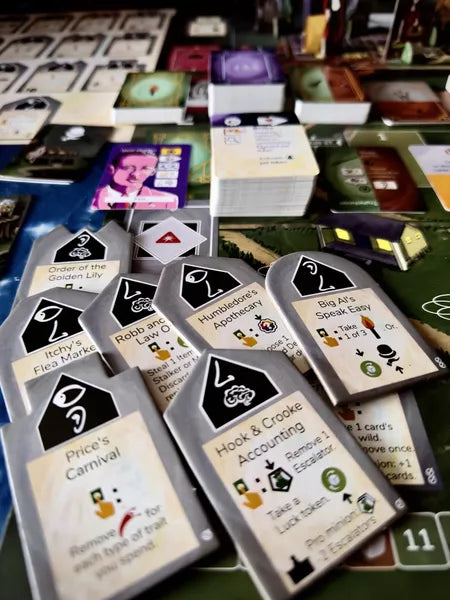Dragon Phoenix Games
Gathering Gloom
- Regular price
- Retail Price: $50.00
- Regular price
-
- Sale price
- $50.00
- Unit price
- per
Couldn't load pickup availability
The Charming family is an eclectic family that lives in a manor on top of the hill in the town of Banebridge somewhere in New England circa 1932. They own the local mortuary as well as a mining company. All they want to do is live in peace, take care of their ancestral home, run their businesses, and get along with the townsfolk. The villagers of Banebridge, however, see it differently. Many of them are firm of the opinion that at least some if not all of the “Charming” family are up to nefarious deeds and are, in fact, “monsters” of various sorts. To that end, they are constantly turning up evidence that implicates members of the family in foul play. Some villagers even start stalking individual members. Sometimes (well, a lot of the time really), the family members are forced to take action to deal with especially difficult villagers or incriminating evidence. Actions include Murder, Terrify, Beguile, Deceive, Extort, Bribe, Coerce, and many more. Of course, the family would NEVER take such actions if the villagers weren’t constantly interfering.
Gathering Gloom is a cooperative game for 1-4 monsters in which the players take on the role of a Witch, a Mad Scientist, a Vampire, a Werewolf, a Zombie, or a Ghost and work to resolve a series of crises at their mansion and businesses. Each character has one or more special abilities and some have vulnerabilities. They use their own attributes as well as those of villagers they have beguiled into minions along with resources on their “Misdeed” cards to resolve 14-16 crises in order to win the game. Gloom gathers every turn based on events as well as from Evidence or Peril cards. If the gloom reaches 50 or more before resolving all the crises, the players lose. Also, if the fear that the villagers have about anyone player reaches twelve or more, the family is exposed and the players lose.
The village has seven locations to visit along with three family locations on the board. There are many things to do on the map since each location has a unique action the player can take. There are also alternate buildings that can be selected at setup to add variety to play.
On your turn, you roll dice to determine events. Then you can move to any location on the board, where you may activate an on-arrival action; you may use cards to perform other actions; you may resolve crises in family locations. Finally, you check to see if any villagers or stalkers are going to activate. You draw up for your next turn, and you are done.
Share



